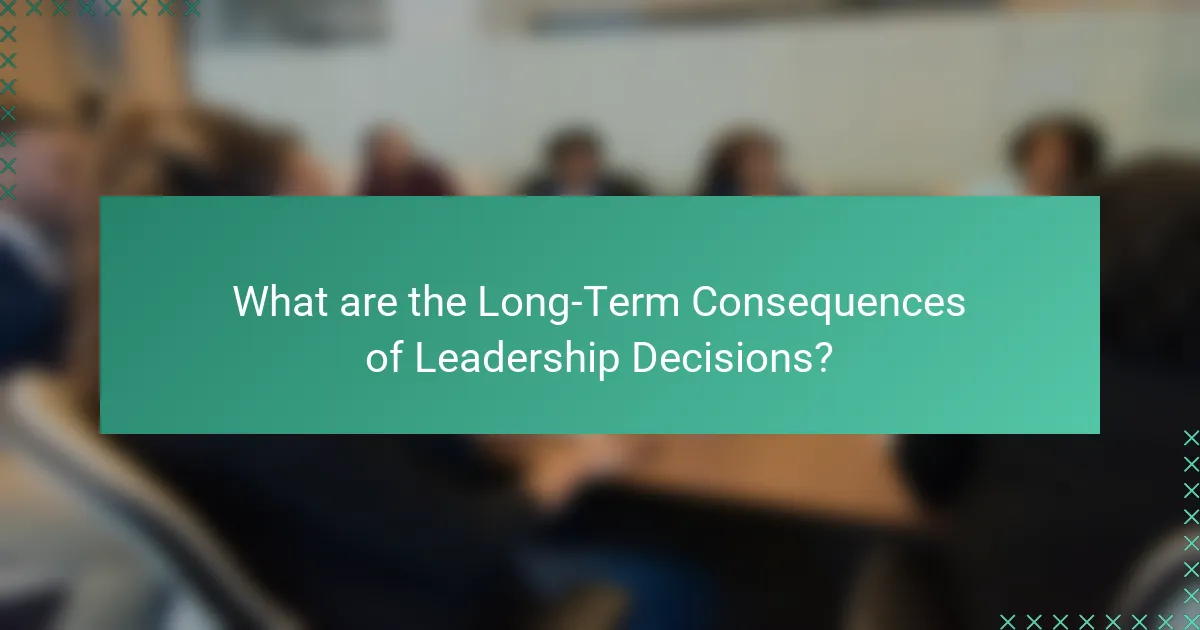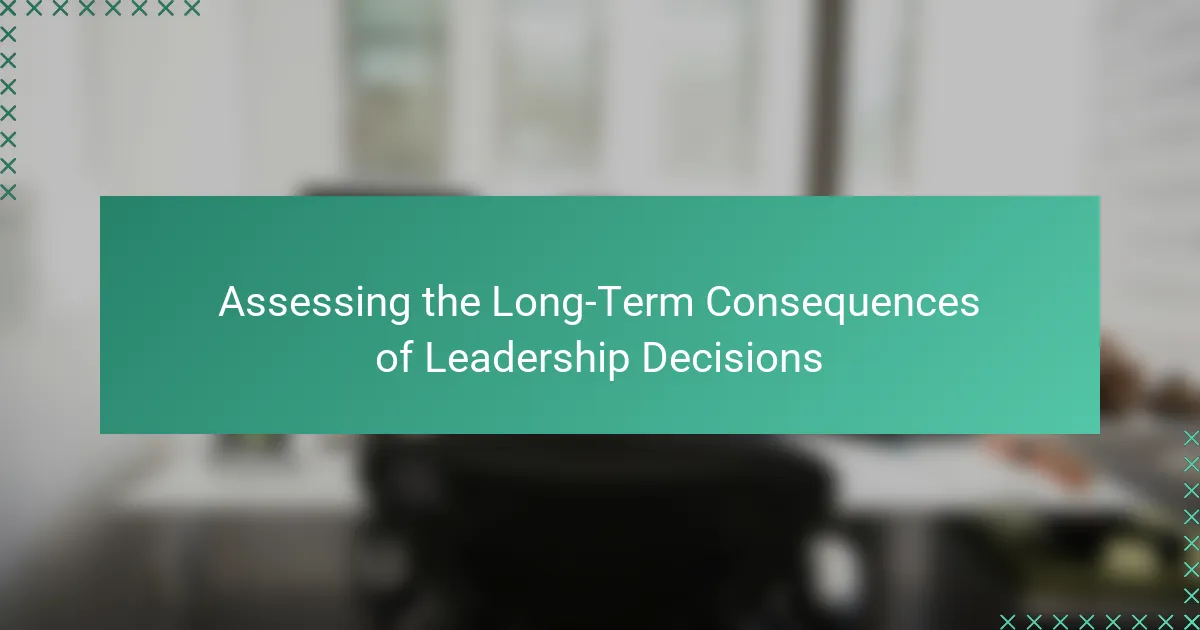Leadership decisions are pivotal in shaping organizational culture, performance, and stakeholder trust. These decisions can lead to significant long-term consequences, such as employee morale and retention rates, with research indicating that organizations with high employee engagement can outperform competitors substantially. Additionally, ethical considerations in leadership are crucial, as neglecting them can harm a brand’s reputation and result in financial losses. This article examines the long-term impacts of leadership decisions, highlighting the importance of effective leadership in fostering innovation and sustainability within organizations.

What are the Long-Term Consequences of Leadership Decisions?
Leadership decisions can have significant long-term consequences on organizational culture, performance, and stakeholder trust. Poor decisions may lead to decreased employee morale and increased turnover rates. For instance, a study by Gallup found that organizations with high employee engagement outperform their competitors by 147% in earnings per share. Effective leadership fosters innovation and adaptability, which are crucial for long-term success. Conversely, decisions that neglect ethical considerations can damage a brand’s reputation, leading to financial losses. Research indicates that 86% of consumers are likely to switch brands if they find a company’s practices unethical. Therefore, leadership decisions shape not only immediate outcomes but also the sustainability and growth trajectory of an organization over time.
How do leadership decisions impact organizational culture over time?
Leadership decisions significantly shape organizational culture over time. These decisions establish the values, norms, and behaviors within an organization. For instance, a leader’s commitment to transparency fosters a culture of openness. Conversely, prioritizing short-term profits may encourage a culture of competition over collaboration. Research shows that consistent leadership behaviors lead to predictable cultural outcomes. A study by Schein (2010) indicates that leadership directly influences cultural alignment and employee engagement. Over time, these cultural shifts can impact employee retention and overall organizational performance. Thus, leadership decisions are pivotal in molding the long-term cultural landscape of an organization.
What specific cultural shifts can arise from leadership choices?
Leadership choices can lead to significant cultural shifts within an organization. For instance, a leader’s commitment to diversity can foster an inclusive culture. This inclusivity can enhance employee engagement and innovation. Conversely, authoritarian leadership may create a culture of fear and compliance. Such environments often stifle creativity and open communication. Research by the Center for Creative Leadership shows that leadership styles directly impact organizational culture. Leaders who prioritize transparency encourage trust among employees. This trust can lead to increased collaboration and improved morale. Thus, leadership choices are pivotal in shaping cultural dynamics in any organization.
How do these cultural shifts affect employee morale and productivity?
Cultural shifts significantly impact employee morale and productivity. Positive cultural changes enhance employee engagement and satisfaction. When employees feel valued and included, their motivation increases. Research shows that organizations with strong cultures have 30% higher employee satisfaction rates. Conversely, negative cultural shifts can lead to decreased morale. This often results in higher turnover rates and lower productivity. Studies indicate that disengaged employees are 18% less productive. Thus, cultural shifts play a crucial role in shaping workplace dynamics.
What role does strategic decision-making play in long-term outcomes?
Strategic decision-making significantly influences long-term outcomes. It shapes an organization’s direction and resource allocation. Effective decisions align with the organization’s vision and goals. They consider market trends and stakeholder needs. Research indicates that companies with strong strategic decision-making outperform their peers. For instance, a study by McKinsey found that firms with clear strategies achieve 3.5 times higher total returns. This highlights the importance of strategic decision-making in sustaining competitive advantage. Moreover, long-term planning fosters adaptability to changing environments. This adaptability is crucial for enduring success. Thus, strategic decision-making is vital for achieving favorable long-term outcomes.
How can strategic decisions shape an organization’s future direction?
Strategic decisions can significantly shape an organization’s future direction by defining its goals and resource allocation. These decisions influence market positioning, operational efficiency, and competitive advantage. For instance, a company that invests in technology can enhance productivity and innovation. Additionally, strategic choices regarding mergers or acquisitions can expand market reach and diversify offerings. Historical examples include Apple, which strategically focused on product design and user experience, leading to substantial market growth. Similarly, companies that fail to adapt, like Kodak, demonstrate how poor strategic decisions can hinder future success. Thus, strategic decisions are crucial in determining the trajectory and sustainability of an organization.
What are the potential risks associated with strategic leadership decisions?
Strategic leadership decisions carry several potential risks. These risks include misalignment with organizational goals, which can lead to wasted resources. Poor decision-making can result in financial losses, as seen in cases where companies fail to adapt to market changes. Additionally, strategic decisions may overlook employee engagement, causing decreased morale and productivity. There is also a risk of reputational damage if decisions lead to public backlash. Furthermore, strategic miscalculations can create competitive disadvantages, impacting long-term sustainability. A study by Harvard Business Review highlights that 70% of strategic initiatives fail due to poor execution and leadership missteps.
Why is it important to assess the long-term consequences of leadership decisions?
Assessing the long-term consequences of leadership decisions is crucial for organizational success. Leadership decisions often shape the direction and culture of an organization. These decisions impact employee morale, productivity, and retention rates. Understanding long-term effects helps in strategic planning and risk management. Historical examples show that poor leadership choices can lead to significant financial losses. For instance, the downfall of companies like Enron highlights the repercussions of unethical leadership. Leaders who consider long-term outcomes are better equipped to foster sustainable growth. Therefore, assessing these consequences is essential for informed decision-making.
How can long-term assessments inform future leadership strategies?
Long-term assessments can inform future leadership strategies by providing insights into the effectiveness of past decisions. These assessments analyze outcomes over extended periods. They help identify patterns and trends in organizational performance. For instance, organizations can evaluate employee retention rates or project success over multiple years. This data reveals which leadership approaches yield positive results. Additionally, long-term assessments highlight areas needing improvement. By understanding these aspects, leaders can make informed adjustments to their strategies. Research shows that companies utilizing long-term performance data achieve better strategic alignment. This alignment leads to enhanced organizational resilience and adaptability.
What methodologies are effective for evaluating these consequences?
Case studies are effective methodologies for evaluating the long-term consequences of leadership decisions. They provide in-depth analysis of specific instances where leadership choices have led to measurable outcomes. Case studies can highlight patterns and trends that emerge over time. Surveys and interviews also gather qualitative data from stakeholders impacted by those decisions. Quantitative methods, such as statistical analysis, offer insights into measurable impacts on performance metrics. Longitudinal studies track changes over time, revealing trends that emerge from leadership decisions. These methodologies collectively enhance understanding of the consequences of leadership choices.
What are the common pitfalls in assessing leadership decisions?
Common pitfalls in assessing leadership decisions include confirmation bias, lack of data, and overconfidence. Confirmation bias occurs when decision-makers favor information that supports their existing beliefs. This can lead to ignoring critical data that contradicts those beliefs. Lack of data can result in decisions based on incomplete information. Without comprehensive data, the assessment of decisions is flawed. Overconfidence can cause leaders to underestimate risks and overestimate their judgment. This often results in poor decision-making outcomes. These pitfalls can significantly distort the evaluation of leadership effectiveness. Research shows that addressing these biases can improve decision quality.
How can biases influence the evaluation of leadership outcomes?
Biases can significantly distort the evaluation of leadership outcomes. They affect how individuals perceive and interpret a leader’s actions and decisions. Common biases include confirmation bias, where evaluators favor information that supports their pre-existing beliefs. This can lead to an inaccurate assessment of a leader’s effectiveness. Another bias is the halo effect, which occurs when a positive trait overshadows negative aspects, skewing overall evaluations. Research by the Harvard Business Review highlights that biases can lead to misjudgments, impacting organizational performance. Thus, recognizing and mitigating biases is crucial for accurate leadership assessments.
What strategies can mitigate these biases in assessments?
Implementing structured assessments can mitigate biases in evaluations. Structured assessments standardize criteria and reduce subjective interpretations. Training evaluators on common biases enhances awareness and reduces their influence. Utilizing multiple assessors can provide diverse perspectives and minimize individual biases. Regularly reviewing and updating assessment criteria ensures relevance and fairness. Incorporating feedback mechanisms allows for adjustments based on past evaluations. Research shows that these strategies lead to more objective outcomes. For instance, a study by Topping et al. (2017) found that structured assessments significantly reduced biases in educational settings.
How can organizations effectively measure the impact of leadership decisions?
Organizations can effectively measure the impact of leadership decisions through quantitative and qualitative metrics. They can analyze employee engagement scores to assess morale and productivity changes. Financial performance indicators, such as revenue growth or cost reduction, provide concrete data linked to leadership actions. Surveys and feedback mechanisms can capture employee perceptions of leadership effectiveness. Regular performance reviews can help track progress against strategic goals. Benchmarking against industry standards offers context for evaluating decisions. Data analytics tools can identify trends and correlations between leadership decisions and organizational outcomes. These methods ensure a comprehensive understanding of leadership impact on the organization.
What metrics are essential for evaluating leadership effectiveness?
Key metrics for evaluating leadership effectiveness include employee engagement, team performance, and turnover rates. Employee engagement measures how motivated and committed staff are to their work. High engagement often correlates with effective leadership. Team performance can be assessed through productivity metrics and achievement of goals. Successful leaders drive their teams to meet or exceed targets. Turnover rates indicate how well leaders retain talent. High turnover may signal leadership issues. These metrics provide a comprehensive view of leadership impact on an organization.
How can feedback from employees enhance the assessment process?
Feedback from employees can enhance the assessment process by providing insights into their experiences and perceptions. This feedback helps identify strengths and weaknesses in leadership decisions. Employees often have unique perspectives that can reveal overlooked issues. Their input can lead to improved strategies for future assessments. Research shows that organizations with regular employee feedback mechanisms see increased engagement and performance. A study by Gallup found that companies with high employee engagement outperform their competitors by 147% in earnings per share. Therefore, incorporating employee feedback is essential for effective assessment.
What best practices can leaders adopt for making sustainable decisions?
Leaders can adopt several best practices for making sustainable decisions. First, they should prioritize stakeholder engagement. Involving various stakeholders ensures diverse perspectives are considered. Second, leaders must utilize data-driven analysis. This approach helps in evaluating the long-term impacts of decisions. Third, integrating sustainability into the core strategy is essential. This ensures that sustainability becomes a fundamental aspect of the organization’s mission. Fourth, leaders should promote a culture of sustainability within their teams. Educating employees on sustainable practices fosters a collective commitment. Fifth, continuous monitoring and assessment of decisions are crucial. This allows leaders to adapt strategies based on changing circumstances. Lastly, transparency in decision-making builds trust and accountability. Research shows that organizations practicing these methods report better long-term sustainability outcomes.
The main entity of the article is leadership decisions and their long-term consequences on organizations. The article examines how these decisions influence organizational culture, employee morale, productivity, and stakeholder trust. It highlights the importance of strategic decision-making in shaping an organization’s future, the potential risks associated with such decisions, and the methodologies for assessing their impacts. Additionally, it discusses common pitfalls in evaluating leadership effectiveness and best practices for sustainable decision-making. The content underscores the critical role of leadership in determining an organization’s sustainability and growth trajectory over time.
